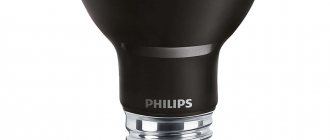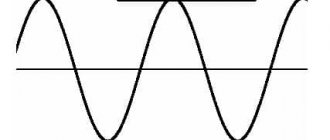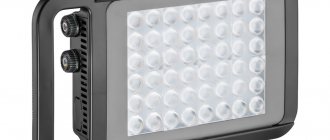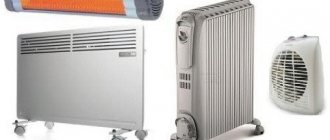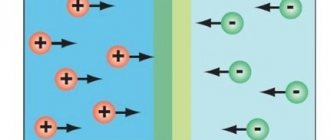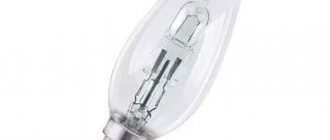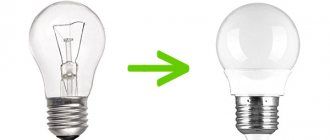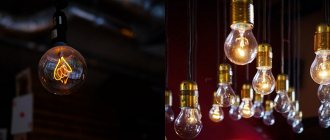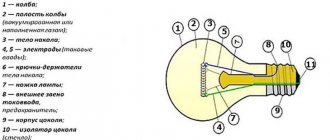The Internet regularly comes across customer complaints about LED lamps that continue to glow dimly or flicker when the lights are off. Atypical behavior of light bulbs is so common that it is useful for any buyer of this product to be aware of it. Let's figure out why an LED lamp burns dimly after turning off, what can cause a similar effect and how to get rid of a non-dangerous but annoying defect.
LED lamps have their own characteristics Source userapi.com
Characteristics
Lamps differ from each other in design and technical characteristics. It is important for the consumer to know the properties of certain light sources. Let's take a closer look at them.
Power. Measured in Watts. Wattage refers to the amount of electricity that a light source consumes. The larger it is, the brighter the light bulb shines. At the same time, high power indicates high energy costs and the size of the bills.
Since the rated power directly depends on the design, to compare different types of lamps it is more convenient to use another characteristic - luminous flux.
Light flow. Measured in lm. Luminous flux shows how bright the light bulb is. New models of light sources (fluorescent and LED) have greater brightness with less power. It is through this that energy saving is achieved.
Comparative characteristics of the power of the most popular household light bulbs with a luminous flux of 1200 lm are given in the table.
Thus, with equal luminous flux, the power of LED lamps is more than five times less than that of incandescent lamps.
Light output. Measured in lm/W. Luminous efficiency shows the luminous flux per 1 W of power. Also a convenient parameter for comparing different types of lighting fixtures. The higher the light output, the lower the power to ensure maximum brightness.
Color rendering index (Ra, CPI). Shows how real colors are distorted under artificial lighting. It is indicated by numbers from 1 to 100. The lower the coefficient value, the more the shades are distorted. An index of 100 means that colors are reproduced as accurately as possible. For indoor vision, it is safer to use light sources with Ra of at least 80.
Colorful temperature. It is measured in K. It determines the warmth of light, because different colors are perceived differently by the eye depending on the lighting.
Colorful temperature
There are several types of color temperatures:
- 2700-3200 – warm white;
- 3300-4000 – neutral white;
- 4000-5000 – cool white;
- 5000-6000 – daylight;
- over 6000 – cold daytime.
Color temperature significantly affects a person’s mood and performance. When choosing lamps, especially for home and work use, carefully study the labeling. Remember that warm colors promote relaxation, and cold colors promote vigor and efficiency. But in large quantities, cold light depresses the nervous and visual systems. You can read more in the article on color temperature
Life time. This is the number of hours the light source will last. The packaging usually indicates the service life when used under ideal conditions. In reality, it may differ from that declared by the manufacturer. The service life of popular household light bulbs is shown in the table.
In addition, many models of light sources lose brightness over time. This is due to the physical processes that make the glow itself possible. These lamps include LED and gas-discharge lamps.
Light scattering angle. This is the angle at which the light flux diverges. An incandescent lamp shines 360⁰ in all directions. But not all types of light sources can boast the same. For example, due to the design features of LED (and other types), the dispersion angle ranges from 30⁰ to 360⁰.
Light scattering angle
Based on the task of the lamp, the optimal angle is selected. For spot lighting, 30⁰ is enough, but for general lighting it is better to choose the maximum angle.
Ripple (flicker) coefficient. Characterizes the uniformity of illumination. Measured as a percentage. The lower the coefficient, the smoother the luminous flux, the less tired your eyes will be. Ideally, for home and office, you should choose light sources with a pulsation coefficient of about 5%. Lamps with a coefficient above 35% are dangerous for vision.
Why are traditional incandescent lamps still popular?
The main advantages of traditional incandescent vacuum lamps include a simple and efficient design, low cost and good color rendering. Research results show that the radiation they emit is practically no different from solar radiation, i.e. familiar to the eye. This group was the first to appear on the market and is currently represented by lamps with different shapes and degrees of transparency of glass bulbs, including those coated with mirror paint with the ability to direct the flow or decorative products that do not require lampshades or bottles.
Here you will find interesting information - at what height from the floor to install the switch.
But that's where the benefits end. In vacuum incandescent lamps, up to 97% of the useful energy is spent on heating the emitting element (namely, the tungsten filament), with the highest surface heat release of all types (on average up to +150 °C, at high power - up to 300 W), they have the most low efficiency.
The rest of the energy is simply dissipated, which, coupled with rapid failure due to frequent changes in operating mode, makes conventional incandescent lamps ineffective and short-lived.
Classification
Incandescent lamps
The very first artificial light source, invented by T. Edison at the end of the 19th century. The glow is based on the passage of current through a tungsten filament. The thread heats up to 3000⁰C and begins to glow. The tungsten helix is placed in a glass flask, which is filled with either inert gases or a vacuum.
Incandescent lamp design
Despite their simple design, incandescent lamps vary in shape, size and purpose. They can operate from different voltages: 220, 12, 24 and 36 V. They shine with a warm light of 2700 K, color rendition is high - over 90. They are produced in different powers and cost little. In addition, they do not depend on voltage fluctuations in the network, operate at sub-zero temperatures, and do not require special disposal.
The disadvantages include minimal light output, high energy consumption, low service life, fragility, and strong heating during operation.
Fashionable vintage Edison lamps have become a modern subspecies. Structurally, they are made in the same way as incandescent lamps, but in the most bizarre shapes, colors and variations. Vintage light sources are used to decorate interiors in antique and loft style.
Example of vintage Edison lamps
Halogen
A modernized version of the incandescent lamp. The main improvement is the addition of halogens (a mixture of bromine and iodine vapors) to the inert gas in the flask. This causes the tungsten ions in the flask to ionize and react with halogen vapors. The resulting molecule settles on the heated spiral and decomposes. As a result, tungsten returns to the metallic phase. The whole process helps to increase service life and light output, reducing the size of the bulb. The reduction in overall dimensions was made possible thanks to the special quartz glass used for the flask. Quartz glass can withstand higher temperatures than regular glass.
Different types of halogen lights
“Halogens” find their application in many areas: street lighting, general and spot lighting in apartments, spotlights, low-voltage lighting, car headlights, etc. They have all the advantages of incandescent lamps and increased luminous efficiency and service life.
The downside is that the flask gets very hot during operation. You should not touch the lamp with your bare hands: there will be grease from your fingers on it, which will ultimately lead to a quick breakdown . Also, halogen lamps are sensitive to voltage changes in the network.
Read more in the article about halogen lamps
Gas discharge light sources (GRL)
The principle of operation of gas-discharge lamps is based on the phenomenon of electric discharge in gases. The appearance of light radiation in different types of GRLs is slightly different physically. And the design has a lot in common.
General device of the GRL
Their general design consists of a discharge tube (or burner) to which electrodes (main and ignition) are soldered. The burner is made of special quartz or ceramic refractory glass. The tube and electrodes are placed in an outer flask. Different gases are pumped inside the flask depending on the type of light source.
The arc lamp device includes a current-limiting resistor, which is necessary to control the discharge occurring in the bulb. Instead of a resistor, external ballasts (chokes) can be used: electromagnetic or electronic. Also, for stable operation, ballasts are included in the circuit, and for initial ignition, a pulse ignition device is included.
GRLs are used in street, household, industrial, automotive, film and theater lighting, and agriculture.
In accordance with the Minamata Convection, from 2022 the production of certain mercury-containing products is prohibited: including DRL, MGL.
The characteristics of some GRLs are given in the table.
DRL
Mercury arc lamps. The radiation occurs due to a column of arc electric discharge. Mercury vapor emits visible blue or violet light and invisible ultraviolet light. The latter excites the phosphor deposited on the inside of the flask. The result is bright white light.
DRL
LL and CFL
Fluorescent and compact fluorescent lamps. The glow is based on an arc discharge that occurs between the electrodes in an atmosphere of inert gases and mercury vapor. The result is ultraviolet radiation that is invisible to the eye. The light is transferred into the visible spectrum by a layer of phosphor deposited inside the bulb. It absorbs ultraviolet light and emits visible light. Depending on the phosphor, different color temperatures are possible.
LL
LLs are more often used for lighting industrial enterprises, workshops and offices. CFL – for household and industrial lighting. Compact lamps feature a spiral-shaped glass bulb. This is done to minimize the size of the lamp. The necessary CFL ballasts are “hidden” in the base.
CFL
A characteristic advantage of LL is the low heating of the flask, and the disadvantage is poor performance at low temperatures (below +5⁰С).
DNAT
Sodium (DNaT). The radiation occurs due to a gas discharge in sodium vapor. The light turns out orange-yellow. Therefore, HPS is used mainly for street lighting and in greenhouses. Also, HPS are characterized by high luminous efficiency (150-200 lm/W) and long service life.
DNAT
MGL
Metal halide lamps. The glow is based on the plasma of a high-pressure arc discharge in vapors of inert gases, mercury and sodium and scandium halides. Depending on the amount of halides, the MGL light spectrum produces a different spectrum (from 3500 to 6000 K).
MGL
MGLs are characterized by high luminous efficiency (70-95 lm/W) and color rendering (Ra more than 90).
Xenon
The glow occurs due to an electric arc in a xenon atmosphere. The spectrum is close to the natural solar spectrum (approximately 4000 K). By adding some additives to xenon, other color temperatures are obtained: 5000 and 6000 K. Xenon lamps are used for car headlights, film and photography (due to high color rendering), in optical instruments, scientific test chambers and installations.
Automotive xenon lamps | Tubular xenon lamps |
Neon
Refers to gas light lamps. Light emission occurs due to the glow of the gas itself when electricity flows. The design of gas-light lamps is simpler than that of gas-discharge lamps: only a tube with an inert gas and two electrodes at the ends of the tube.
Depending on the type of inert gas, neon lamps produce a different glow.
Gas light lamps
Different shades are obtained by mixing gases (sometimes green-blue mercury vapor is added) or by applying a phosphor to the flask.
They are used mainly for decorative purposes and in outdoor advertising.
LED
Emission in LED lamps is based on the phenomenon of recombination in two different semiconductors. The former is dominated by electrons, the latter by positively charged ions. When current flows between conductors, electrons and holes recombine with each other at the interface of materials. As a result, light radiation appears. Depending on the semiconductor materials, the wavelength of light and its color temperature differ.
LED design
An LED lamp consists of LEDs, a heatsink, a driver, a diffuser and a base. The heatsink removes excess heat from the LEDs. The driver equalizes the supply voltage and converts alternating current into direct current. In inexpensive light bulbs, the driver is replaced by a power supply that does not stabilize the current. The diffuser is not available on all models. It distributes the light flux in space and prevents moisture and dust from entering. Sometimes the inside of the diffuser is coated with a phosphor.
The positive aspects of LED light sources include:
- energy saving;
- long service life;
- no strong heating during operation;
- wide range of color temperatures: from 2700 to 6500 K;
- mechanical strength; the ability to work with a damaged lens;
- decorativeness;
- environmental friendliness.
The negative aspects include:
- high price;
- flickering (especially in cheap models without a driver);
- decrease in brightness during operation due to degradation of LEDs;
- high percentage of defects;
- the luminous flux is narrowly directed.
LED light sources are used almost everywhere: household (general and spot) lighting, street, decorative.
They operate on alternating (220) and direct voltage (4, 12 V). Available with different bases: pin and screw.
Filament
A type of LED, similar in appearance to incandescent lamps.
Filament lamp
Designed for decorative use in open lamps and chandeliers. The filament is replaced by an LED filament. The thread is made of glass (sapphire), on which 28 LEDs (blue or mixed with red) are applied. The thread is coated with a layer of phosphor to create white light (up to 4500 K). The driver in this case is located in the base.
Filament light sources are available in low power: from 4 to 8 W. As a rule, one thread corresponds to 1 W.
Type "corn"
“Corn” is an LED lamp on which the LEDs are arranged in a circle. It shines in all directions at 360⁰. Often "corn" does not have a diffuser.
"Corn"
These lamps shine brightly in all directions. They are used where bright, economical lighting is needed. It is better to use indoors as there is no diffuser. But “corns” are also produced for outdoor use to replace gas-discharge lamps.
Energy-saving lamps. These include light sources that, with the same luminous flux as an incandescent lamp, have less power. For domestic use, compact fluorescent and LED lamps can be called energy-saving.
For comparison, you can take different types of lighting lamps with an equal luminous flux of 1200 lm.
The table shows that the power of CFLs and LEDs is significantly less than that of incandescent lamps. True, energy-saving lamps are much more expensive. However, after 1-1.5 years of operation, savings on electricity bills are achieved. Especially if you replace powerful incandescent lamps (over 60 W), and replace them in rooms where the light is on constantly. In the basement, an energy-saving lamp will not pay for itself.
Infrared lamps
It is more of a source of heat than light. Their design is based on an incandescent lamp. Only the spiral does not heat up to the temperature of visible light. The radiation comes in the infrared range, invisible to the eye. Therefore, the lamp emits more heat.
Infrared lamp
Lamps come with glass and ceramic bulbs. They are used for heating rooms, greenhouses, terrariums, aquariums, and in medicine. The peculiarity of heating is that it is not the air that is heated, but the object itself (a person or a chicken). Therefore, such lamps are suitable for heating open areas.
Kerosene lamps
Kerosene lamp
Light source based on kerosene combustion. Kerosene is poured into the container. It rises through the wick into the combustion zone, where it burns, producing light. In another design, close to a primus, instead of a wick, a tube is used under pressure, which is created by a hand pump.
They were used before the widespread use of electricity in the 19th and early 20th centuries. Today they are used where there is no electricity, by tourists, for decorative purposes.
Quartz lamps
quartz lamp
They are a low glass gas discharge lamp with a quartz glass bulb. Inside there is a mixture of inert gas and mercury. When passing through an electrical discharge, mercury vapor produces ultraviolet radiation. Quartz glass allows them to pass through.
Thanks to ultraviolet light of a certain wavelength, viruses and bacteria are neutralized. Therefore, quartz lamps are actively used for disinfecting premises, instruments, and water. They are also used to irradiate young animals on poultry farms and children to prevent rickets.
Types of quartz lamps include ultraviolet and bactericidal. They differ slightly in design, purpose and operating conditions.
LED light bulbs
The LED always emits light in one direction. This feature is determined by its location on the substrate. The direction of light in LED bulbs depends on the geometry of the light emitters. Taking this into account, you need to choose a light bulb for a lamp or chandelier. Newer design variations are filament light bulbs. They imitate incandescent light bulbs and create light that is directed most evenly in all directions.
They use microcircuits in the form of threads. The thread is actually a narrow sapphire ribbon backing. Crystals and resistors are formed on it by analogy with an LED strip. These bulbs are ideal for a variety of fixtures with a design adapted to incandescent bulbs. The LED light bulb is powered by an electronic ballast, similar to that used in an energy-saving light bulb.
LED lamp models
To compare different types of light bulbs according to their main characteristics, below is a table and illustration. They clearly show the advantages of LED lamps. Despite the higher price, these light sources pay for themselves in full.
Table of main characteristics of different types of lamps
The most common types of light sources
Choosing the right light source
When choosing lamps for lighting, be guided by operating conditions, area and purpose of the room (or open area).
HID lamps are not used for home lighting. They gradually die off due to the presence of mercury in the composition. Sodium lamps for street lighting are often replaced with LED lamps.
For household lighting, incandescent, halogen, fluorescent and LED lamps are most suitable. To illuminate rooms where the light is on rarely and little by little, it is quite possible to use incandescent lamps. They are also indispensable for lighting steam rooms (Led and CFL in them will not withstand high temperatures). A halogen lamp is also suitable for a steam room.
LED light sources are suitable for constantly illuminated rooms. At the same time, pay attention to the color temperature: for rest rooms - warm colors, for work rooms - neutral or cold.
CFLs should not be used in the heat or at temperatures below 5⁰C.
LED strips and flexible neon are suitable for decorative lighting and advertising.
Spot lighting can be easily organized using halogen or LED spots.
When lighting damp rooms (cellar, basement), it is better to use low-voltage lighting.
Halogen lamps: pros and cons
The group includes lamps with E- or G-base, characterized by increased light output in compact sizes. In terms of variety of shapes, they are not inferior to conventional vacuum ones, but, thanks to the increased proportion of quartz in the glass and filling the flask with gas, their filaments do not turn black and last longer. The quality of the light they produce remains high throughout their entire service life.
The disadvantages are manifested in the sensitivity of halogen lamps to voltage changes and pollution. Such lamps, if possible, are connected via a transformer (in houses with frequent voltage surges and drops, this condition is mandatory) and are installed exclusively with gloves, quickly burning out if fat accidentally gets on the quartz flask.
The unprotected surface of a high-power halogen lamp heats up to 250 °C in operating mode; it is not recommended to operate them without shades in children's or similar rooms. But lamps with medium power and a protected housing can be fixed in plasterboard structures without any problems.
Where to use fluorescent lamps
The group of fluorescent lamps is represented by lamps with different standard sizes of G-base, and emission spectrum - from pure white to natural. The desired option is selected thanks to the marking. Special attention is paid to these indicators; not all fluorescent lamp sockets are suitable for domestic use, and the mountings on the bulbs cannot be changed. The exception is advanced compact energy-saving types.
The general advantages of fluorescent lamps include low heat generation from the housing, good efficiency, softness and uniformity of the output luminous flux (provided by a phosphor coating over the entire internal area of the bulb) and long service life.
The disadvantages are manifested in the relatively high price, the dependence of the quality of light on the ambient temperature (when it goes below zero, the light begins to dim), a large proportion of UV in the output spectrum, which in turn is fraught with irritation for people with sensitive skin, inertia when turned on, hum in the working mode and a significant reduction in service life with frequent switching on/off of the lamp. Due to the mercury vapor in the bulb, fluorescent lamps require expensive disposal and there is no possibility of recycling.
An improved subtype are energy-saving fluorescent lamps with an electronic unit in the base that regulates work processes. While retaining all the advantages of conventional fluorescent lamps (wide color range, high efficiency), energy-saving varieties benefit in durability by 3-5 times.
But they are not intended for illuminating large areas and, for obvious reasons, this variety is more expensive. The requirements for disposal during their operation are also unchanged: after failure, energy-saving lamps cannot simply be thrown away; if the bulb is accidentally damaged, the surfaces under the lamp are forcibly cleared of mercury.

